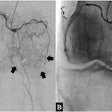Endovascular thrombectomy (EVT) may improve outcomes in stroke patients compared with medical management – importantly, even when imaging suggests varying ranges of brain injury, according to a study published February 7 in JAMA.
In a clinical trial, EVT improved clinical outcomes after 90 days in patients with a wide spectrum of infarct volumes (stroke sizes) assessed either by CT or MRI imaging at baseline, noted a group led by Amrou Sarraj, MD, of Case Western Reserve University in Cleveland, OH.
“EVT treatment effects and outcomes may differ by imaging selection modalities and are not well characterized in patients with large ischemic cores,” the group noted.
EVT is a minimally invasive image-guided surgical procedure that can be used to dissolve blood clots in stroke patients, and thus restore blood flow to prevent further brain damage. It has proven to be safe and effective in stroke patients with limited tissue damage on baseline neuroimaging up to 24 hours after patients were last known to be well, the authors noted.
Yet whether EVT is as effective for treating a range of ischemic injury assessed on different imaging modalities has not been established, the authors noted.
To bridge this gap in knowledge, the group analyzed data from a clinical trial comparing the use of EVT versus standard medical management in 336 adults with acute ischemic stroke at 31 global centers between October 2019 and September 2022.
All patients received standard neuroimaging exams – either noncontrast CT, CT/MR angiography, or CT perfusion or MR diffusion-perfusion imaging – at the time of presentation. The researchers analyzed relationships between imaging estimates of irreversibly injured brain tissue and at-risk regions and EVT clinical outcomes.
Treatment effects were reported as adjusted generalized odds ratios (aGenORs), with aGenORs of greater than 1 indicating better functional outcome on modified Rankin Scores (mRS). mRS is a scale ranging from 0 to 6, with 0 indicating no symptoms and 6 indicating death.
Based on a standard CT scoring system for stroke severity, EVT improved functional outcomes compared with medical management alone in patients with mild (aGenOR, 1.71), moderate (aGenOR, 2.01), and severe (aGenOR, 1.85) tissue damage, according to the findings.
In addition, across strata for CT perfusion/MRI ischemic core volumes, aGenORs for EVT versus medical management was 1.63 for volumes less than or equal to 70 mL, 1.41 for volumes less than 100 mL, and 1.47 for volumes less than 150 mL.
Moreover, imaging discordance between the two imaging modalities was frequent, but did not alter EVT treatment effects, the authors noted.
“While functional outcomes worsened as baseline ischemic core volumes increased, endovascular thrombectomy was associated with better clinical outcomes across a wide spectrum of ischemic changes and penumbra profiles on various imaging modalities compared with medical management,” the researchers concluded.
The full article can be found here.



















